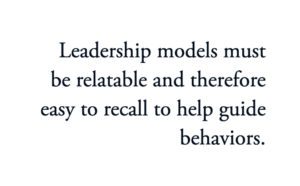
An organization’s leadership model will serve as an effective guide for decision-making and team engagement when it is “sticky,” has meaning, and people can easily grasp how the model links back to organizational objectives.
by Andrea Derler
August 17, 2020
How does your organization define what “good” leadership looks like? Now think about a colleague in your organization. Would this person’s response be the same as yours?
Most likely, the answer to this second question is no.
Too often, there is a lack of alignment around an organization’s leadership model, a specific set of phrases that is designed to guide leadership behavior across a particular organization. It is meant to provide a succinct description of what leaders need reminding of most often. For example, HP’s leadership model asks its leaders to “Imagine the future, inspire the team, and make it happen” and thereby captures the company’s mission to use a growth mindset, to collaborate and to execute.
Are you asking the right questions in the model design process?
It can be a long and arduous process to design an effective leadership model that results in consistent leadership behavior across the organization. Many design teams spend months and sometimes years creating a leadership model. And yet, our research at NeuroLeadership Institute has found that many business leaders struggle to remember these models, let alone defer to them in times of need. As a result, organizations end up with relatively complex models that lack a clear connection to the business objectives, do not mesh with existing talent systems and seldom influence leaders’ behaviors.
As part of a nine-month industry research project, we interviewed 17 talent professionals and surveyed 568 leaders and individual contributors at different levels and across a wide range of industries about their leadership models. There are leaders who indicated that they apply their organization’s leadership model in everyday interactions with team members, in decision-making processes, and to guide their actions and behaviors. According to our data, the key is to design brain-friendly leadership models that help leaders answer three questions.
Question No. 1: Can I remember this? Creating a “sticky” model.
Forty-one percent of organizations’ leadership models contain five or more core phrases, and almost half of the surveyed HR leaders said their models are made up of more than 21 desired leadership behaviors. This can be a problem because leadership models that are exhaustive and ask individuals to remember a long list of phrases and desirable behaviors are much less likely to be adhered to. About one third of leaders in our survey find their leadership models complicated and wordy, and only 17 percent said their organization’s leadership models were “definitely easy to remember.”
It’s common to create long and complex leadership models, for various reasons, as this HR leader shared with us:
“When I was junior in talent management, I was all about the competency model, because I loved reveling in the complexity of it. I realize now I was missing the point. It wasn’t to show how much I understood it. The point was to get others to know it as intimately as I could but with two minutes of effort versus the two hours of effort I was putting in.”
 Conventional wisdom says leadership models should be exhaustive, detailed descriptions of key behaviors that embody the characteristics of good leadership. Scientific research suggests otherwise: Models must be relatable, thus being easy to recall to help guide behaviors.
Conventional wisdom says leadership models should be exhaustive, detailed descriptions of key behaviors that embody the characteristics of good leadership. Scientific research suggests otherwise: Models must be relatable, thus being easy to recall to help guide behaviors.
Leadership models should intentionally factor in the brain’s limited capacity for processing a vast amount of information at once. This allows people to effectively use the models to guide their behavior.
Employees have so many demands that eat up precious resources in the brain. The prefrontal cortex — the region of the brain that sits directly behind the forehead — is the cognitive system that supports working memory and temporarily holds various pieces of information (like a shopping list) at once. The volume of information impacts the prefrontal cortex’s ability to retain and process that information.
Question No. 2: Do I care about this? Ensure the model is meaningful.
Leadership models that are sticky but don’t carry meaning for people are like pop music or trivia — it’s information we can’t get out of our heads but that ultimately does little for us. Meaningfulness can have various connotations. For us, it is about application to an individual’s respective job.
When we asked leaders more directly about their model’s meaningfulness, nearly 40 percent said they weren’t sure or they felt it was not meaningful, and 27 percent said the model was “definitely” meaningful. Just 28 percent said they use their organization’s leadership model in critical manager-employee situations.
Each time we face a moment to act, we assess how much we care about the goal and how confident we feel that we can succeed. Science backs this up. Human motivation to take action is rooted in value and expectancy. Value is the quality of that outcome being meaningful in the first place. Expectancy is the assumption that things will turn out for the better, in concordance with our goal. The strongest motivation comes when both value and expectancy are high.
When it comes to leadership models, effective outcomes stem from leaders having clarity around expectations (the “what” and the “why”) and the confidence to successfully execute. The moment one of these components is missing or is not satisfactory, it shifts how people evaluate a situation and what behavior they perform as a result.
A U.S.-based financial services organization was aiming for employees to be more collaborative and overcome existing silos between departments. NLI worked with the company to design their brain-based leadership model. One of the core phrases is “Build Bridges.” This phrase is sticky, represents what people need reminding of most often and is meaningful in the context of the desired culture shift. It is also actionable and forms an image in one’s mind of reaching across boundaries to eliminate barriers to collaboration.
Keep in mind the questions posed by one our interviewees:
“When you start to develop the leadership model, you get a lot of people having questions. Does this really help anyone? And I think that if most of us are honest, in the dark moments, we ask ourselves: ‘Is this actually helping people be better?’ Because if not, then all I’ve done is codify something that everyone already knows and experiences. So, why does it matter?”
Question No. 3: Does it fit with what I am asked to do? Avoid conflicting messages.
In our survey, we asked how many organizations have additional models or frameworks for leaders to adhere to. Only 24 percent said their organization uses just one leadership model; 76 percent said the organization uses additional business, culture and mission frameworks.
While having multiple models isn’t necessarily bad, trouble arises when the models don’t make sense with one another. There needs to be coherence, meaning that behaviors and ideas form a consistent and unified whole. If each individual model is sticky, and the  expectations are meaningful, leaders may still be left wondering what they are supposed to do if a given model disagrees with other organizational competencies, values, frameworks and expectations.
expectations are meaningful, leaders may still be left wondering what they are supposed to do if a given model disagrees with other organizational competencies, values, frameworks and expectations.
If a leadership model clashes with existing schemas, expectations or objectives, it will likely create cognitive dissonance for employees. Essentially, this is the mental discomfort we feel when our beliefs, expectations, values or actions don’t fit together. To relieve the psychological stress of processing contradictions, leaders may instead fall back on their tried-and-true behaviors in an unconscious effort to keep mental resources in check.
Microsoft’s culture change, inspired by CEO Satya Nadella’s mission to create a culture of “learn-it-alls” (as opposed to “know-it-alls”), was partly expressed in what the company calls “leadership principles” that NLI helped co-create. Microsoft is about innovation, empowerment and growth mindset. The leadership principles — create clarity, generate energy, and deliver success — represent what Microsoft wants to be and where they want to go strategically.
Communication around the company’s strategy and the related leadership principles is consistent and coherent throughout the company. For example, Nadella speaks openly about them as the “attributes of leadership” in interviews. Joe Whittinghill, Microsoft’s general manager of talent, learning and insights, says that Microsoft’s leadership principles have “exploded like wildfire throughout the company,” in part because the message is clear and causes no conflict with other objectives.
Coherence is the most underestimated component of leadership model design. It is critical for model adoption and is evident when the behaviors outlined in the leadership model align conceptually with what is communicated via other channels across the organization.
Tips
It is clear from our research that an organization’s leadership model will serve as an effective guide for decision-making and team engagement when it is easy to remember (stickiness), the components matter (meaning) and people can easily grasp how the model links back to organizational objectives (coherence). Such models may also be easier to implement, inform learning strategies and enable real behavior change to support the overarching strategies of the business.
Of course, designing an effective leadership model is far from a straightforward process. Design teams tend to be intentionally exhaustive rather than focused on the essential elements, leading to the implementation of models that don’t lead to desired behaviors. To help prevent this, remember these three design tips to create brain-friendly leadership models:
- Keep the brain — and its limitations — in mind when brainstorming the number of model values (supporting stickiness).
- Make the model your own instead of copying and pasting from existing models (supporting meaningfulness).
- Ensure alignment between the leadership model and your business strategy (supporting coherence).
After embarking on this journey, we are quite confident that colleagues across the organization will define and apply leadership in a similar way, resulting in consistent behaviors that guide effective decision-making.



